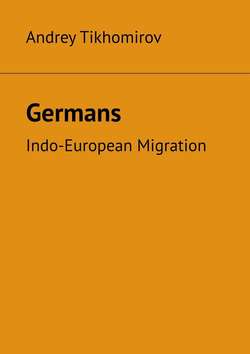Germans. Indo-European Migration

Реклама. ООО «ЛитРес», ИНН: 7719571260.
Оглавление
Andrey Tikhomirov. Germans. Indo-European Migration
The formation of the ancient Indo-Europeans in the Southern Urals – Black Sea
Germanic peoples
Germanic languages
References
Отрывок из книги
Modern archaeological research proves that the homeland of the Indo-Europeans is the region of the Southern Urals, where they formed as a single language group.
Communities are created, first on the basis of common origin – childbirth, and as marketable products increase, a large family community is formed, consisting of phratry, i.e. several genera. Then the neighboring community in the form of a tribe, the next step – the union of tribes, leading, in turn, to the formation of the people, and then the state. But for any community, a community of interests is also necessary, in this case, the protection of metallurgists and their products. So there were settlements of ancient metallurgists, and in particular, the Arkaim culture of the South Urals. Similar settlements were found in Europe, in Germany near Dresden and Leipzig, as well as in Austria and Slovakia, under the age of 7 thousand years. After the end of natural resources, the settlements were “closed”, the ditches were filled up, and the remains of the dwellings were burned.
.....
In the Avesta, the god Ahura Mazda (an extremely knowledgeable priest) advises the legendary immaculate king of the ancient Aryans (Indo-Europeans) Yime to create a giant fence – Varu, and there, for this fence put “the seed of all the males and females that are greatest on this earth, and the seed of all genera cattle, and the seed of all plants. And to do everything in pairs, while people are in Var … " The legendary Vara consisted of 3 circles, enclosed one in another. From the extreme 9 passages were conducted, from the middle – 6, from the internal – 3. And on this territory fenced off from evil winds, Yima built 18 streets, and created a window above the top – something like a chimney for smoke. The patron of forging in the Slavic pagan pantheon was the blacksmith god Svarog (Sanskrit. “Svarga” – heaven). The image of Svarog is close to the Greek Hephaestus and Prometheus.
The sun – Yes-God – in Slavic mythology was thought of as the son of Svarog. The ancient Slavic god – Dazhdbog – the bearer of happiness, most likely symbolizes rain, for example, in Slovak dažď (read “dazhd”) – rain. “Wind is blowing” is the analogy of a man who blows from his mouth. “Blind rain” means it is raining and the sun is shining, and so it turns out that it is as if the rain “does not see” and goes where the sun is shining. In the Christian folk calendar, Svarog turned into saints Kozma and Demyan – patrons of blacksmithing and marriage. The very presence of the gods – the patrons of forging – indicates the antiquity of its origin. With the word “Svarog”, the word “Swastika” (Skt.) Is idiomatically similar – a cross with ends bent at right angles, one of the oldest ornamental motifs found among the peoples of India, China, Japan, where the swastika sign also had religious significance. Compare also the Slavic words “cook”, “welding”. In the steppes of the Urals-Altai, forging has already reached significant development among the Scythian tribes of the Northern Black Sea Region (7—4 centuries BC), as well as among the Sarmatians and Slavs known in the 4th – 6th centuries. under the name of ants. In the 10—11 centuries. iron and steel products in Russia were widespread and had diverse applications. The ancient metallurgists usually concentrated in their hands both the smelting of iron from the swamp ore, the so-called “cooking” of iron, and the manufacture of various iron products, as well as the forging of copper, tin, silver and gold, especially in jewelry. A hearth was used, where clods of swamp ore from above and below were covered with coal, which was ignited and heated to the desired temperature. The molten iron flowed to the bottom of the hearth and formed a viscous mass (crits). The blacksmith took it with pincers and then, forging it with a hammer on the anvil, gave the product the desired shape, knocked slags from the surface and reduced the porosity of the metal. The development of iron led to a significant leap in development. In addition, deposits of tin and copper, and their alloy of bronze, in the habitat of the ancient Indo-Europeans were practically absent, they were imported from other territories. Iron ores were more widespread than copper and tin, iron ores were formed in large quantities under the influence of microorganisms in swamps and stagnant water bodies. And the area of distribution of the ancient Indo-Europeans was precisely characterized by an abundance of lakes and wetlands. Unlike copper and tin, in ancient times iron was mined everywhere from brown iron ore, lake, swamp and other ores. A prerequisite for the widespread use of iron metallurgy was the use of a raw-cheese process, in which reduction of iron from ore was achieved at a temperature of 900 degrees, while iron was melted only at a temperature of 1530 degrees, to produce iron by a raw-iron method, the ore was crushed, calcined over an open fire, and then in pits or small clay foci where charcoal was laid and air was blown by bellows, iron was restored. A scream formed at the bottom of the furnace (compare Krishna from Sanskrit, lit. – “dark, black”, one of the revered gods in Hinduism). – a lump of porous, pasty and heavily contaminated iron, which then had to be subjected to repeated hot forging.
.....